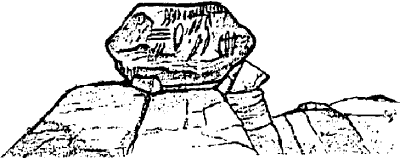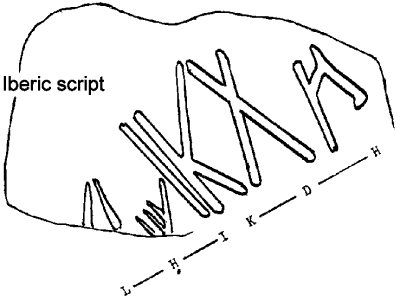 |
Science Frontiers ONLINE No. 32: Mar-Apr 1984 |
|
|
Two Remarkable Inscribed Stones
The first stone is located in western Colorado on a remote canyon ledge, overlooking a broad valley with a stream.
"The dolmen is four feet across the top and has three placed stones holding it above the ledge in a level position approximately six feet from the cliff face. The Ogam on top of the capstone is intermixed with cupule-like depressions ranging in size from 7 "-9 " long, 3"-3 " wide and 1 "-1 " deep in the center. The cupule-like depressions are very striking because of their uniformity, smoothness, and peculiar shape. The Ogam on the side of the capstone is abundant and occasionally connecting with lines on the top. The surface of the dolmen was obviously smoothed and prepared for the inscriptions. The actual age is unknown but the desert varnish on the Ogam, the depressions, and the smoothed surface is substantial."
 |
|
The Colorado inscribed dolmen in situ. The top is also inscribed. |
- Top: God is strong. Strong to help his right hand.
- Front: The Koran is the unique achievement of the prophet pious and tender.
(Morehouse, Judy; "A Colorado Dolmen Inscribed with Ogam," Epigraphic Society, Occasional Publications, 11:209, no. 269, 1983.)
Comment. A photograph accompanying the article shows a striking artifact with strongly engraved markings.
The second stone was discovered at a petroglyph site in south central Alabama. This stone has an apparent jumble of scratches or grooves on two faces, which one might easily ascribe to plows. Barry Fell, however, considers them obvious Iberic letters. His translation of the Arabic:
- Top: A vegetable garden. Cession of land, a conveyance of property.
- Side: Cession of land, a conveyance of property.
(Henson, B. Bart, and Fell, Barry; "Inscribed Rocks in South Central Alabama," Epigraphic Society, Occasional Publications, 11:235, no. 274, 1983.)
Comment. The large number of North American sites with enigmatic marks documented by the Epigraphic Society elicits several questions:
- Are the sites and artifacts genuine? In view of the large number discovered at various times, in various places, by different people; some would certainly seem to be legitimate.
- Are the markings really ancient Ogam, Libyan, and similar brands of old writing? Admittedly, some grooves and scratches on small stones may have been created by random processes, but others, like the extensive series in West Virginia reported in SF#27, must be manmade. Comparisons with similar Old World inscriptions suggest that again the answer must be "yes."
- Were there really ancient Celts, Romans, Arabs, Egyptians, and other peoples in North America well before Columbus? The large number of old inscriptions would argue for a "yes," but one must also wonder what these old explorers or colonists did except carve symbols on rocks. Where are the expected artifacts, such as pottery, campsites, etc.? Certainly, the conventional archeological literature, which we survey, is devoid of any references to such artifacts. The data recorded above are certainly not being incorporated into mainstream science.
Reference. Many other enigmatic North American inscriptions are described in our Handbook: Ancient Man. Ordering information may be found here.
 | The upper, or principle, face of the inscribed stone from Alabama. |